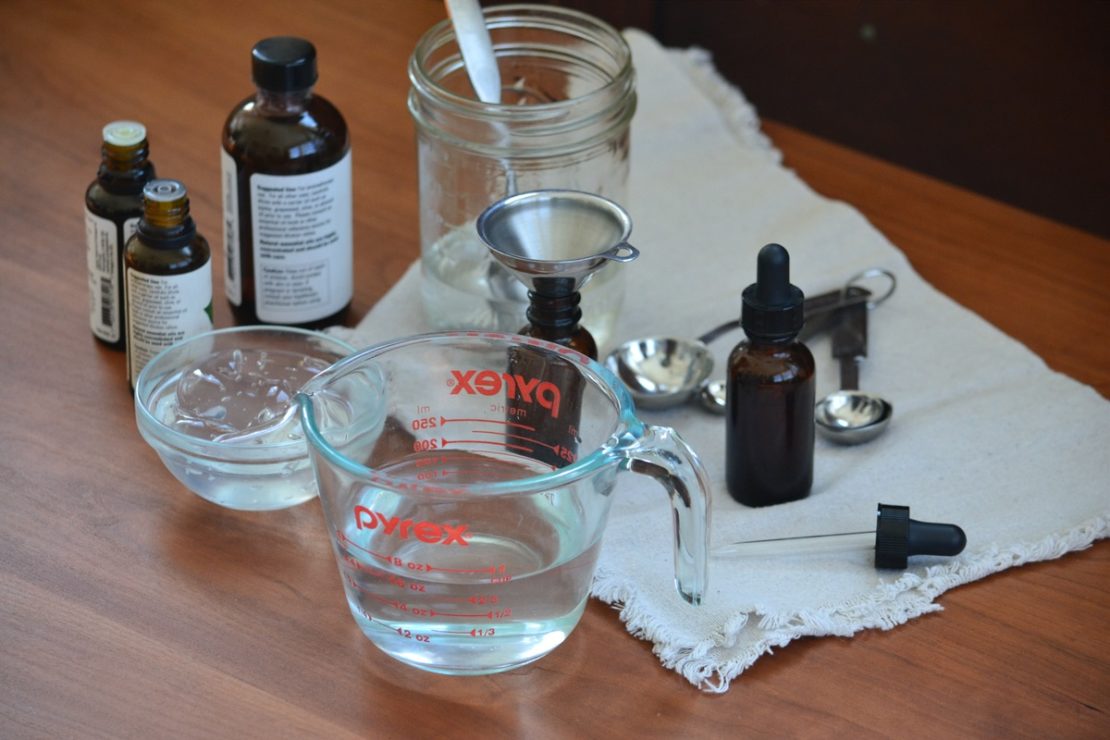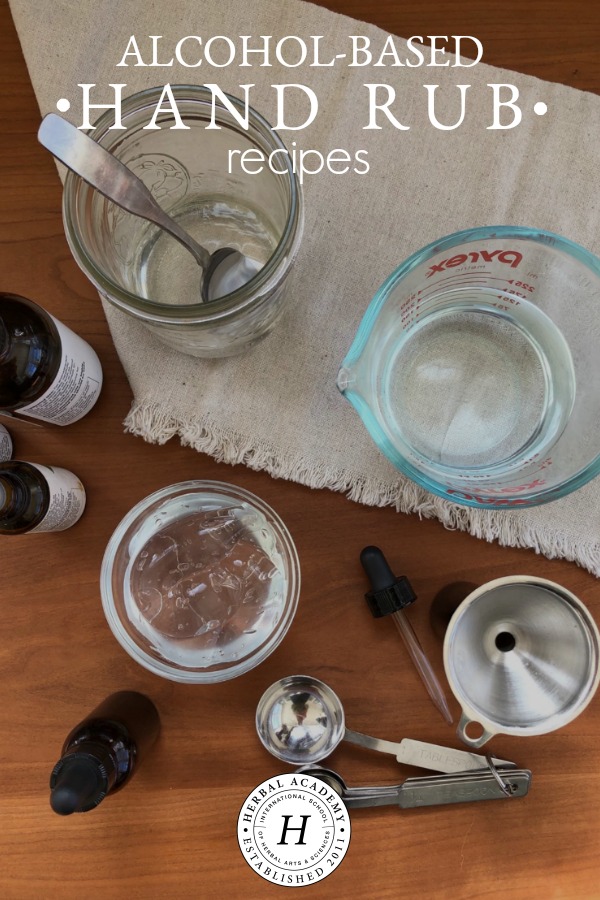
3 Alcohol-Based Hand Rub Recipes
The most important prevention measures we can take right now are staying home and practicing social distancing if leaving the house for essential work or trips to the grocery store or pharmacy—that is, staying at least 6 feet away from other people (Centers for Disease Control [CDC], 2020a). Washing hands thoroughly with soap and warm to hot water for at least 20 seconds after being in a public place, after sneezing or blowing your nose, and before eating, drinking, or handling food is also crucial to prevent the spread of the virus; however, if handwashing isn’t possible, the CDC recommends the use of an alcohol-based hand rub with at least 60% ethanol or 70% isopropyl alcohol until you can wash your hands again (CDC, 2020a; CDC, 2020b).

Folks have taken this approach to heart, clearly, because commercially available hand sanitizers are in seriously short supply these days! However, with a short list of ingredients, you can make a similar alcohol-based hand rub at home. The key is to make sure it contains enough alcohol. You can use either isopropyl alcohol (e.g., rubbing alcohol), which contains 91% alcohol (if you can only find 70% rubbing alcohol, this could be used straight on the skin, but could not be diluted further in the recipe below; unfortunately, it is drying to the skin) or you can use 190-proof ethyl alcohol (e.g., grain alcohol, grape alcohol, or cane alcohol), which contains 95% alcohol. Note that most vodka is 80- or 100-proof (40% or 50% alcohol), which is too low for this purpose. In some states, 150-proof (75%) grain alcohol is available, and we include a recipe specifically for that.

These alcohol-based hand rub recipes make a bit more than 8 fl oz of hand rub; you can store this in a glass pint jar and then transfer it into smaller bottles for trips outside the house. Alternatively, feel free to scale the measurements down to make a smaller batch.
We include some suggestions for some optional essential oils you can add to your alcohol-based hand rub, however, you can also choose to add whichever essential oils you have on hand, at their appropriate dilution amounts. If using these recipes with children, opt for 10 drops of essential oils (this is a 0.25% dilution) or omit the essential oil altogether. Note that peppermint (Mentha x piperita) essential oil should not be used for children under age 6, while eucalyptus (Eucalyptus globulus) essential oil should not be used for children under age 10. While many essential oils have antimicrobial properties, keep in mind that the alcohol is doing the heavy lifting in these alcohol-based hand rub recipes, so the essential oils are not necessary for that purpose.

If desired, you can replace some of the thick aloe gel with glycerin, however, the thick aloe gel is the carrier agent that appropriately disperses the essential oils in the formulation, so it cannot be replaced entirely. Note that aloe juice or thin aloe gel are not acceptable substitutions for thick aloe gel (sometimes referred to as aloe jelly), as they do not adequately disperse essential oils in solution. Limit glycerin to 5% of a recipe so the hand rub isn’t too sticky! For the 8 fl oz batches below, this is about 2.5 tsp (0.42 fl oz); substitute this for 2.5 tsp of the thick aloe gel.
If you can’t find thick aloe gel, you can substitute glycerin for the entire amount of thick aloe gel in your alcohol-based hand rub, but you will need to eliminate the essential oils from the recipe, and if the glycerin is more than 5% of the recipe it will be a little sticky. You could also substitute in some hydrogen peroxide or distilled water as the non-alcohol recipe component (World Health Organization, n.d.) along with glycerin to keep glycerin in the non-sticky territory of 5%.
With that said, here are 3 alcohol-based hand rub recipes for you!

Alcohol-based Hand Rub with 91% Rubbing Alcohol
74% alcohol content
6.5 fl oz 91% isopropyl alcohol
3 tbsp (1.5 fl oz) thick aloe (Aloe vera) gel
20-40 total drops essential oil(s) of choice (optional) – tea tree (Melaleuca alternifolia), lavender (Lavandula angustifolia), peppermint (Mentha x piperita), eucalyptus (Eucalyptus globulus)
- Combine thick aloe gel and essential oils (if using) in a glass pint jar and stir well. Add isopropyl alcohol and either cover and shake well, or transfer ingredients to a very clean blender to mix and then transfer to glass pint jar for storage.
- Label and store out of reach of small children.
- Shake well and pour into labeled small glass dropper bottles as needed.
- Shake well before each use, then squirt onto hands, rubbing in thoroughly so the solution covers all areas of the hand.

Alcohol-based Hand Rub with 190-proof Grain, Cane, or Grape Alcohol
65% alcohol content
5.5 fl oz 190-proof (95%) grain, cane, or grape alcohol
5 tbsp (2.5 fl oz) thick aloe (Aloe vera) gel
20-40 total drops essential oil(s) of choice (optional) – tea tree (Melaleuca alternifolia), lavender (Lavandula angustifolia), peppermint (Mentha x piperita), eucalyptus (Eucalyptus globulus)
- Combine thick aloe gel and essential oils (if using) in a glass pint jar and stir well. Add alcohol and either cover and shake well, or transfer ingredients to a very clean blender to mix and then transfer to glass pint jar for storage.
- Label and store out of reach of small children.
- Shake well and pour into labeled small glass dropper bottles as needed.
- Shake well before each use, then squirt onto hands, rubbing in thoroughly so the solution covers all areas of the hand.
Alcohol-based Hand Rub with 150-proof Grain Alcohol
66% alcohol content
7 fl oz 150-proof (75%) grain alcohol
2 tbsp (1 fl oz) thick aloe (Aloe vera) gel
20-40 total drops essential oil(s) of choice (optional) – tea tree (Melaleuca alternifolia), lavender (Lavandula angustifolia), peppermint (Mentha x piperita), eucalyptus (Eucalyptus globulus)
- Combine thick aloe gel and essential oils (if using) in a glass pint jar and stir well. Add alcohol and either cover and shake well, or transfer ingredients to a very clean blender to mix and then transfer to glass pint jar for storage.
- Label and store out of reach of small children.
- Shake well and pour into labeled small glass dropper bottles as needed.
- Shake well before each use, then squirt onto hands, rubbing in thoroughly so the solution covers all areas of the hand.

REFERENCES
Centers for Disease Control. (2020a). How to protect yourself. Retrieved from https://www.cdc.gov/coronavirus/2019-ncov/prepare/prevention.html
Centers for Disease Control. (2020b). CDC statement for healthcare personnel on hand hygiene during the response to the international emergence of COVID-19. Retrieved from https://www.cdc.gov/coronavirus/2019-ncov/infection-control/hcp-hand-sanitizer.html
World Health Organization. (n.d.) Guide to local production: WHO-recommended handrub formulations. Retrieved from https://www.who.int/gpsc/5may/Guide_to_Local_Production.pdf







